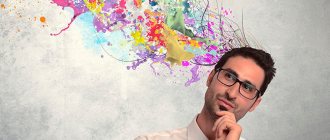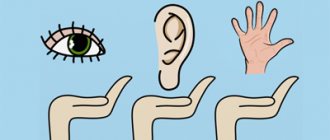In children starting school, “memory becomes thinking, and perception becomes thinking.” The statement of the outstanding child psychologist, author of original methods, D. B. Elkonin means the main thing: in the mental development of children of primary school age, an active transformation of the entire cognitive sphere (memory, attention, perception, speech) occurs. Psychologists emphasize that such improvement of the psyche is possible only with abstract logical thinking. Experts authoritatively state that abstract thinking is necessary not only for the further mental development of a child, but also for mastering such complex academic subjects as mathematics, natural history, and later, physics, geometry, and astronomy. It is important for parents to understand the diversity of their child’s mental development in order to come to the rescue in time.
What is this thought process?
Thinking in abstract terms is an important stage in personality development. This is thinking about objects or people that are not immediately present before the eyes. For example, instead of thinking about the red apple in the bowl in front of you, you think about the apple orchard you walked through in the summer. Abstract thinking is unique to the human species and is an ability that can be developed over time.
As children grow and their thinking matures, they begin to think more about what happened in the past and what might happen in the future. Today, artificial intelligence robots, which are used in many children's apps and games, threaten the development of abstract thinking. Programs cannot make decisions and see cause-and-effect relationships like humans. They clog the child’s brain, preventing him from thinking more broadly and abstractly.
Disappointed in the institution of marriage, Nadezhda Mikhalkova reflects on the film “Dad”
The interweaving of Orthodoxy and military affairs in the Main Church of the Russian Armed Forces
Elegant shoes 2021: the hottest trends
Forms
Abstraction is the abstraction of some properties of objects from others in order to identify their features. The definition of abstract thinking is almost the same. This phenomenon refers to a type of intellectual activity during which a person thinks about a situation, separating it from some details. Abstractness has a significant impact on the physiology of thinking and allows you to cross certain boundaries, discovering new knowledge.
This type of thinking develops in parallel with ontogenesis from an early age. It first appears at the moments when the child begins to fantasize, composing his own stories or acting out unusual situations, and abstracts himself from toys, preferring to think about their certain properties.
Abstract thinking is divided into forms, each of which corresponds to the characteristics of the thought process accompanied by abstraction. There are 3 of them in total:
- Concept. Involves defining one common property for different objects. A very important point is the significance of this unifying feature. For example, the legs of tables or green leaves of different trees.
- Judgment. In judgment, an affirmation or denial of a certain event occurs. Everything is usually described in a phrase or short sentence. Judgments can be simple or complex. In the first case, they relate to one active object or person (for example, “the boy bought milk”). In the second, the judgment affects several sides at once (“clouds appeared, it became dark outside”). It can also be true, based on subjective conclusions, or false, based on personal interest.
- Conclusion. Inference is understood as a thought, the formation of which occurs on the basis of several judgments. It consists of premises, conclusion and conclusion. All three processes occur sequentially in the human head. It all starts with initial judgments (premises), then moves to the stage of reflection (conclusions), and ends with the formation of a new judgment (conclusion).
Abstract thinking can be used in any of these three forms. An adult uses them all in everyday life. Nevertheless, it is necessary to develop them even for those who are good at abstraction.
Modern artificial intelligence is endowed with abstract thinking that is superior in quality to human thinking.
AI threatens abstract thinking
A few centuries ago, scientists may have compared our intelligence to that of animals. But today we measure human intelligence against artificially intelligent robots. The better we design robots, the more we risk that they may threaten human individuality. At the same time, they help solve problems in many areas.
The main thing that AI is not yet capable of is supporting abstract thinking. Gadgets develop children's visual perception of information, simplifying it as much as possible. But, spending too much time on the phone, the child forgets how to think abstractly. Therefore, you need to engage with it more often, and not allow yourself to be entertained for days with smart electronic “toys.”
Reading and making up stories as a means of abstract thinking
Good stories create tension between concrete and abstract thinking. On the one hand, stories have a specific plot (something happens to someone), which is often followed by a moral lesson. On the other hand, stories have an aesthetic quality that gives them the power of art. While storytelling is grounded in lived reality, art tends to be more abstract.
So the Russian people do not give up: why did the “guests” receive a “fly” in taverns?
Lamination or extensions: beauty treatments for eyelashes in 2021
A group of scientists came to the conclusion that plant pollen reduces immunity
Quality children's books provide educational and aesthetic experiences for both parents and children. For example, picture books may have illustrations with dual meanings, one relevant to a young reader and one relevant to an adult reader. It is also helpful to listen to audiobooks, where the voice-over does not automatically start, but creates moments of silence that parents and children can fill with their own words.
Ask the question “why?”
When reading books with children, ask them the question along the way: “Why is this?” For example, ask: “Why did Little Red Riding Hood go into the forest?” Parents can draw on the child's previous experiences or wishes for the future, encouraging them to reason and reflect. If your digital book contains an AI feedback system, it can also prompt some reasoning, but it is unlikely to cope as well as parents with leading questions.
But you shouldn’t answer your own questions or explain absolutely everything to your child. Abstract thinking requires more effort than quick, concrete thoughts. Many adults think they are helping their children when they explain and detail every aspect. However, research shows that when children think about things on their own, their thinking develops better.
The number of twins born in the world is growing every year
Choose tender and juicy pancakes according to your taste: from pork, chicken or beef liver
With a wrap and buttons: trendy styles of dresses for spring for any figure
So, the next time you read stories with young children, don't just say, “The boy is crying,” but start asking questions: “Why is the boy crying? What would you do in his place? Your child may come up with different reasons, and you can discuss their likelihood together. An AI robot would immediately give the correct answer, but you and your child can talk about different options and hypotheses.
How else to develop abstract thinking
Count everything around with your child more: birds, steps of the stairs, plates on the table, and so on. Teach him the rules of counting, starting with small numbers. While walking around the city, discuss the sights you see. Later, ask your child to create models of these landmarks using toys. Play searching for hidden objects in the house using a drawn map.
Prepare counting materials (sets of molds, construction set parts, buttons, pebbles) for mathematical games with your child. Young children sometimes cannot apply their knowledge of numbers, although they can recognize and read them. Also teach your child how to make different shapes from cubes and encourage problem solving. Encourage children to use counting material for arithmetic, creating geometric shapes and modeling.
Classify objects according to characteristics using different characteristics and categories. When cleaning, put together items of the same shape, color, and purpose with your child. For example, divide them into those that can be rolled or not. All this will also develop abstract thinking.
On the ladder of abstractions
A good teacher tries to rank his students according to different levels of thinking. American linguist and psychologist S.I. Hayakawa came up with an original technology for analyzing complex objects, known in scientific circles as the “ladder of abstractions.” According to this technique, you start analyzing a system from its simplest, specific levels - initial data, for example. Then you take one step “up” - say, describe this data using a theoretical pattern. The key point here is the adequacy of the problem and the level of abstractions applied to its solution. Accordingly, the teacher must set each student tasks that are suitable for the teenager in terms of difficulty level. At first glance, this requirement seems banal, but it is violated all the time: teachers clumsily try to force the entire class to work on the upper steps of the “ladder of abstractions.” For example, we rank the questions according to the degree of generalization: “How do oil prices affect political stability in oil-producing countries?” “How did oil prices affect the Arab Spring in Egypt?” Obviously, the first question is located higher on the “ladder of abstractions”, since it requires broader generalizations for an answer. Accordingly, it should be given to students who are more prepared for such levels of thinking. In practice, it is put before teenagers who have not even reached the level of the “lower” task. Sean is convinced that the importance of exploring the levels of abstract thinking cannot be overstated. A generation of people is growing who consider mathematics to be occult, mystical knowledge. Why? Because we arrogantly do not appreciate the concreteness of young consciousness, which is the first step to the heights of the “adult” mind... Mathematical education researcher, founder of the KillMath project Bret Viktor spoke more categorically, “The power to understand and predict the movement of the world should not belong to arrogant tricksters who fool us with tricks with abstract words.”
Talk to your child more often
Discussion is necessary so that the child can switch from what he heard and saw to himself, his thoughts. Be sure to discuss with him the events that happened to you, what you saw on a walk, on TV. This will help the child operate with symbols abstractly and learn to represent ideas. This may be difficult at first, but as skills develop, the baby will learn to operate with abstract concepts.
Let the child try to think about his upcoming day and tell him what he will do tomorrow. When solving a problem, let him look for different available methods and approaches. Ask your child not only to speak his thoughts, but also to sing them, play them like an actor, and express them using all children’s “languages.” The next stage of development is the child’s creation of his own crafts, stories, and music. Such activities will develop his abstract thinking as effectively as possible.
Found a violation? Report content
Exercises for adults
It is quite difficult for an adult to develop abstract thinking, because... his intellect has long been formed. However, with the help of some exercises you can still achieve results. It is recommended to perform them daily for several weeks.
The most effective exercises:
- Representation of emotions. You need to mentally imagine exactly how different emotions manifest themselves in a certain person. It is recommended to use the full range of people's possible feelings.
- Reverse reading. You need to turn the book over and read it in reverse order. In parallel with this, it is necessary to establish logical connections between various events. It is best to choose simple works written in easy language.
- Analysis of communication. You should remember all the people with whom you had to communicate during the day. It is necessary to analyze not only the conversation itself, but also the facial expression, gestures and voice of the interlocutor. It is recommended to do this with your eyes closed.
- Inventing contradictions. You just need to come up with different phrases that seem contradictory. They can be absolutely anything (hot ice, bitters, etc.).
- Compiling abbreviations. It is enough to come up with any phrase, shorten it to the first letters, and then decipher it throughout the day. For example, independent development of thinking (SDM).
- Listing the functions of objects. You need to select any existing item and list all its functions. You can even come up with unusual purposes that are not usually used.
- Brainstorm. You need to choose any letter of the alphabet and write it on a piece of paper. The task is to remember the maximum number of words starting with this letter in a limited amount of time, writing them all down on paper.
- Combination of words. You need to write nouns on one piece of paper, and adjectives on the second. This does not need to be done right away. It's best to start with just one noun. You will need to select suitable, as well as completely incompatible adjectives for it. All of them should be written down in different columns.
- Title of a painting from life. It is required to visually record any event that happened in reality and give it an unusual name. It should be what an artist might call a painting.
- Painting. You need to paint any pictures using colored paints. During the process, the characteristics of all present items should be presented. If it is not possible to use paints, you can start with regular pencil drawing.
The listed methods will help develop abstract thinking also in a teenager or an elderly person. You just need to apply them on a regular basis, without missing regular classes.










